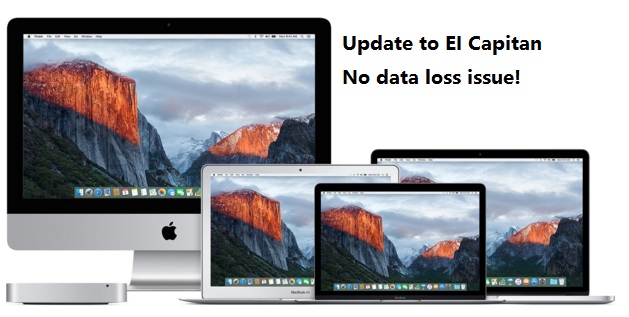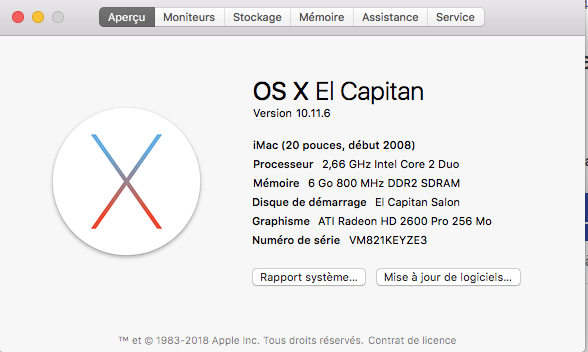Performing an El Capitan-to-Sierra upgrade is easy. Although it does not come like a push-one-button-and-proceed method, the truth is it’s quite close.
Dec 11, 2018 Download Free Mac OS X El Capitan 10.11.1 Mac Dmg. Click on the button below to start downloading Mac OS X El Capitan 10.11.1 for mac OS X. We are here to provide to clean and fast download for Mac OS X El Capitan 10.11 dmg. This link is resume able within 24 hours. Keep visiting themacgo the world of dmgs.
- Download Java for OS X 2017-001 Java for macOS 2017-001 installs the legacy Java 6 runtime for macOS 10.13 High Sierra, macOS 10.12 Sierra, macOS 10.11 El Capitan, macOS 10.10 Yosemite, macOS 10.9 Mavericks, macOS 10.8 Mountain Lion, and macOS 10.7 Lion.
- May 24, 2020 Hello eveyone, Thank you for reading, i'm 76 old an no specialist of informatics;o( My personnel informations: MacBrook Pro 10 years old in good state equipped with El Capitan program level 10.11.6 My question: I see your version of for downloading OBS Studio is higher than my possibilities.
Requirements for Upgrading from El Capitan to Sierra
Before we proceed with our step-by-step guide, allow us to answer an important question that some Mac users have in mind: “Can an old Mac still upgrade to Sierra?”
The screen shot below shows Apple’s install of gcc, marked as MacOSX GCC, because I’d previously installed Xcode on that Mac.)ConfigurationNewbies may want to select the Hello World project just to see how things get set up. Download eclipse for macos pc. (It may be different than the default install by Apple’s Xcode. Name the project, make sure you’ve identified the location of your compiler in the Toolchain, and so on.
The answer is, of course, a YES. However, there are a few minimum requirements that need to be met, such as the following:
- 2 GB RAM
- 8 GB Storage Space
- Mac Models: Late 2009 iMac, 2009 MacBook, 2010 MacBook Pro, 2010 MacBook Air, 2010 Mac Mini, 2010 Mac Pro
Once you are certain that your Mac has met the requirements above, make sure you have backed up your Mac. This backup will come in handy in case something comes up in the process of upgrading to High Sierra.
Upgrading from El Capitan to Sierra
After backing up your Mac’s important files and folders, it’s time to get started. Here’s how to upgrade from El Capitan to Sierra.
1. Download High Sierra from the App Store.
High Sierra is available for download from the App Store. To get it, follow these steps:
Well you can have the newest version of this software p0sixspwn 1.0.8. Is posixspwn 1.0.8 the latest update for el capitan. This software tool can finds that able to jailbreak both Mac and Windows running computers.
- Open the Mac App Store by simply clicking on the App Store icon in the dock.
- Navigate to the Featured tab.
- Find macOS Sierra in the rightmost column and click on it.
- Click Download.
- At this point, the download will start. It may take long, especially if it’s your first time accessing the App Store. Just be patient.
- Once the download is completed, the installer should launch automatically.
2. Start the Upgrade.
With the High Sierra installer ready, it’s time to actually install it. Here’s how:
- The High Sierra installer should now be open on your Mac. If you have accidentally quit it, you can restart it by going to the Applications folder and double-clicking on the installer.
- Click Continue to proceed.
- Press on the Agree button to agree with the software licensing terms and agreements flashed on your screen.
- Click on the Agree button again to verify your action.
- Hit Install.
- A new dialog box will pop up, requiring you to input your administrator password. Provide that information and click Add Helper.
- The High Sierra installer will begin copying the system files to the new target drive. The progress will show in a new window.
- As soon as all the system files are copied, your Mac will automatically reboot. Don’t panic if the restart process takes a while. It only means your Mac is coping with the installation process.
3. Utilize the Setup Assistant to Complete the Installation.
Your Mac should already be finished with the basic installation process. The next thing you should do is run the Setup Assistant to configure some important macOS High Sierra options and settings.
Take note, though, that if your Mac is configured to ask for your login details, a normal login window will show. Provide your login credentials so you can proceed with the following steps:
- The Setup Assistant starts off by asking you for your Apple ID details. If you wish to leave everything as it is, click the Set Up Later option.
- Let the Setup Assistant configure all vital services that need your Apple ID credentials. Simply provide your Apple ID password and hit Continue.
- Click Agree if you agree with the Terms and Conditions flashed on your screen.
- You will be asked to verify your action again. To continue, click Agree again.
- The Setup Assistant should then continue with configuring your iCloud account information. It will also ask you whether you want to set up iCloud Keychain. You can just skip it to avoid confusing yourself.
- Next, there will be options displayed on your screen regarding how you wish to use iCloud for storing images and documents. Choose which of them apply to you by clicking on the boxes next to each one of them:
- Store Files from Documents and Desktop in iCloud Drive – This option will allow you to automatically upload files from your Desktop and Documents folder to your iCloud Drive. Be mindful, though, that Apple only offers a limited amount of storage space for free users. If all this free space is exhausted, you will be asked to purchase additional storage.
- Store Photos and Videos in iCloud Photo Library – This will let you upload videos and images from your Photo Library to iCloud. As with the first option, you have to remember that you only have limited free storage space.
- Hit Continue.
- Wait for the Setup Assistant to finish the setup process.
- You will know when it’s done because you will be taken to your desktop.
Summary
We hope you found this guide useful. But before you download macOS Sierra and perform an upgrade, do not forget to clean up your Mac with a reliable Mac repair tool first. This way, you can ensure that nothing comes your way and keeps you from making the most of High Sierra.
Did we miss some important steps above? Do you know other, easier methods to upgrade from El Capitan from Sierra? We’d love to know. Comment on them below!
DOWNLOAD NOW!
If you’re running into errors and your system is suspiciously slow, your computer needs some maintenance work. Download Outbyte PC Repair for Windows, Outbyte Antivirus for Windows, or Outbyte MacRepair for macOS to resolve common computer performance issues. Fix computer troubles by downloading the compatible tool for your device.macOS Catalina gives you more of everything you love about Mac. Experience music, TV, and podcasts in three all-new Mac apps. Enjoy your favorite iPad apps now on your Mac. Extend your workspace and expand your creativity with iPad and Apple Pencil. And discover smart new features in the apps you use every day. Now you can take everything you do above and beyond.
Check compatibility
If you're using one of these computers with OS X Mavericks or later,* you can install macOS Catalina. Your Mac also needs at least 4GB of memory and 12.5GB of available storage space, or up to 18.5GB of storage space when upgrading from OS X Yosemite or earlier.
MacBook introduced in 2015 or later
MacBook Air introduced in 2012 or later
MacBook Pro introduced in 2012 or later
Mac mini introduced in 2012 or later
iMac introduced in 2012 or later
iMac Pro (all models)
Mac Pro introduced in 2013 or later
* To upgrade from Lion or Mountain Lion, first upgrade to El Capitan, then upgrade to Catalina. To find your macOS version, Mac model, memory, and storage space, choose About This Mac from the Apple menu . If your Mac isn't compatible with macOS Catalina, the installer will let you know. View the complete list of compatible computers.

Make a backup
Before installing any upgrade, it’s a good idea to back up your Mac. Time Machine makes it simple, and other backup methods are also available. Learn how to back up your Mac.
Get connected
It takes time to download and install macOS, so make sure that you have a reliable Internet connection. If you're using a Mac notebook computer, plug it into AC power.
Download macOS Catalina
If you're using macOS Mojave, get macOS Catalina via Software Update: Choose Apple menu > System Preferences, then click Software Update.
Or use this link to open the macOS Catalina page on the App Store: Get macOS Catalina. Then click the Get button or iCloud download icon.
Begin installation
After downloading, the installer opens automatically.
Click Continue and follow the onscreen instructions. You might find it easiest to begin installation in the evening so that it can complete overnight, if needed.
If the installer asks for permission to install a helper tool, enter the administrator name and password that you use to log in to your Mac, then click Add Helper.
Allow installation to complete

Please allow installation to complete without putting your Mac to sleep or closing its lid. Your Mac might restart, show a progress bar, or show a blank screen several times as it installs both macOS and related updates to your Mac firmware.
Stay up to date
After installing macOS Catalina, you will be notified when updates to macOS Catalina are available. You can also use Software Update to check for updates: Choose Apple menu > System Preferences, then click Software Update.

Or get macOS Catalina automatically
If you're using OS X El Capitan v10.11.5 or later and your App Store preferences or Software Update preferences are set to download new updates when available, macOS Catalina will download conveniently in the background, making it even easier to upgrade. A notification will inform you when macOS Catalina is ready to be installed. Click Install to get started, or dismiss the notification to install later. When you're ready to install, just open the file named Install macOS Catalina from your Applications folder.
Learn more
Apple Os X El Capitan
- If the installer shows a list of apps that are not optimized for your Mac, learn about 32-bit app compatibility, then choose whether to proceed with the installation.
- For the strongest security and latest features, upgrade to macOS Catalina. If you have hardware or software that isn't compatible with Catalina, you might be able to install an earlier macOS, such as Mojave, High Sierra, Sierra, or El Capitan.
- You can also use macOS Recovery to reinstall macOS.



